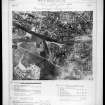Glasgow, Govan Road, Linthouse Engine Works And Shipyard
Engineering Works (19th Century), Shipyard (19th Century)
Site Name Glasgow, Govan Road, Linthouse Engine Works And Shipyard
Classification Engineering Works (19th Century), Shipyard (19th Century)
Alternative Name(s) Alexander Stephens And Sons; Holmfauld Road; Linthouse Shipbuilding Yard; Offices
Canmore ID 44195
Site Number NS56NW 35
NGR NS 540 660
NGR Description Part removed to NS 31491 38354
Datum OSGB36 - NGR
Permalink http://canmore.org.uk/site/44195
- Council Glasgow, City Of
- Parish Govan (City Of Glasgow)
- Former Region Strathclyde
- Former District City Of Glasgow
- Former County Lanarkshire
Alexander Stephen House, 21 Holmfauld Road, 1914
Simple classical office block, for Alexander Stephen, shipbuilder. Red brick on ferro-concrete frame, treated as pilaster strips. Wallhead balustrade to flat roof over main cornice. Off-centre entrance door, with sidelights and fanlight. Offices to south, larger windows to workshop on other side.
Taken from "Greater Glasgow: An Illustrated Architectural Guide", by Sam Small, 2008. Published by the Rutland Press http://www.rias.org.uk
NS56NW 35 540 660 [Part removed to NS 3148 3832]
For engine works building (removed to NS 3148 3832, within the Scottish Maritime Museum complex), see also NS33NW 63.01.
See Architecture (RCAHMS survey 1980's).
Founded 1869 by Alexander Stephen & Sons, and subsequently greatly extended. An engine works was added in 1872 and substantial additions made in 1905, 1908 and 1914. The three-storey 3-by-7 bay red brick office block was built in 1914 (?14,438). A large complex of mainly single storey red-brick, corrugated-iron and corrugated-asbestos-clad steel buildings.
J R Hume 1974.
(Location cited as NS 540 660 and name as Linthouse Shipbuilding Yard). Founded 1869 by Alexander Stephen & Sons. The most interesting part of this large complex is the original cast-iron-framed engine works of 1872.
J R Hume 1976.
The engine works building has been moved to the Scottish Maritime Museum, Irvine.
Information from RCAHMS (RJCM), July 1995
This site has only been partially upgraded for SCRAN. For further information, please consult the Architecture Catalogues for Glasgow District.
January 1998
Publication Account (1986)
Completed in 1872, this engine-shop formed part of the 35-acre (14 ha) shipbuilding yard of Alexander Step hen and Sons established three years previously on the country estate of Linthouse, S of the River Clyde. Subsequently modified, and by 1980 the only workshop of the complex not dismantled, it consisted of two parallel machine-halls with clear spans of 53 ft (16.15m) and an original estimated length of 240 ft (73m) subdivided into 20 ft (6.10m) bays by stanchions and terminal brick piers. They were flanked by 33 ft-wide (10.06m) aisles containing lofts covered by a continuation of the main roof slopes, and the s side also had a second aisle of similar width. Apart from the use of malleable iron plate-girders for the gantries the structural techniques show no advance on those employed in the previous examples. The I-section stanchions, each said to weigh 6 tons (6.1 tonnes), had web-flange dimensions of 36 in (0.91m) by 18in (0.46m). Specific points were the integral castings for the brackets carrying the gantry, the tier of twin binding-beams, and the different treatment of the centre and flanking rows of stanchions at gantry level. A novel feature was the mid-point support between stanchions for the roof structure, achieved by a combination of coupled beams and a centre-post held in suspension by tie-rods, slung between the stanchions to connect with a stirrup and cross-beam. Bracket jib-cranes with wooden booms were fixed to alternate stanchions in both machine halls and aisles.
Information from ‘Monuments of Industry: An Illustrated Historical Record’, (1986).
Desk Based Assessment (October 2001)
Archaeological desk based study carried out on Glasgow Harbour by FIRAT Archaeological Services.
Publication Account (2009)
The Linthouse Engine Works and Shipyard also has surviving historic elements, though these are scattered. Alexander and Sons formed the yard from the Linthouse estate from 1869 and the yard eventually closed in 1968. The in situ surviving element of the complex is a reinforced concrete and brick office block of 1914 on Holmfauld Road (fig 5.13). The iron- and timber-framed engine works (1872) was removed in 1986–90 to the Scottish Maritime Museum in Irvine (fig 5.14), the largest historic building to have been relocated in Scotland (Hay and Stell 1986, 121–4). Parts of the site have seen recent redevelopment by Barr and Stroud/Thalys. A notable related survival is part of the Linthouse Buildings tenement block, which housed workers from the yard.
Information from ‘The Scottish Burgh Survey, Historic Govan: Archaeology and Development’ (2009).



























































































































